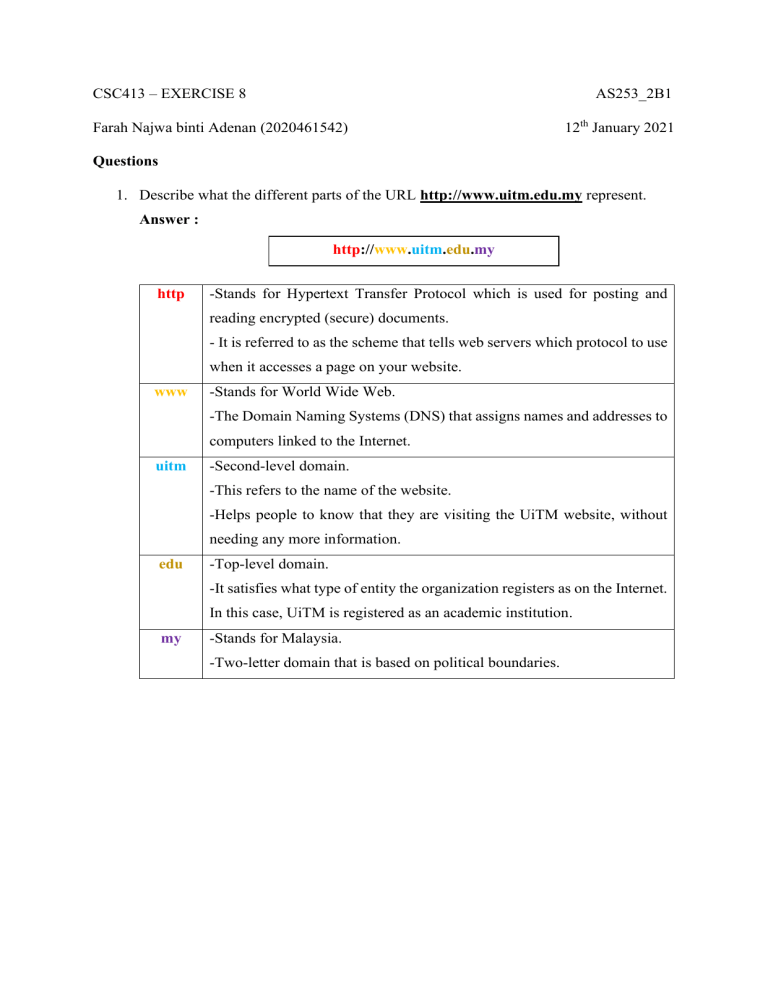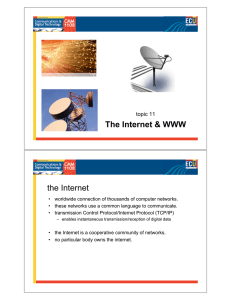Networking Exercise: URLs, Data Transfer, Bandwidth, Daemons
advertisement

CSC413 – EXERCISE 8 AS253_2B1 Farah Najwa binti Adenan (2020461542) 12th January 2021 Questions 1. Describe what the different parts of the URL http://www.uitm.edu.my represent. Answer : http://www.uitm.edu.my http -Stands for Hypertext Transfer Protocol which is used for posting and reading encrypted (secure) documents. - It is referred to as the scheme that tells web servers which protocol to use when it accesses a page on your website. www -Stands for World Wide Web. -The Domain Naming Systems (DNS) that assigns names and addresses to computers linked to the Internet. uitm -Second-level domain. -This refers to the name of the website. -Helps people to know that they are visiting the UiTM website, without needing any more information. edu -Top-level domain. -It satisfies what type of entity the organization registers as on the Internet. In this case, UiTM is registered as an academic institution. my -Stands for Malaysia. -Two-letter domain that is based on political boundaries. 2. Explain the process of data is transfer from the server to client. Answer : In a network, the server computer provides network services to the client computers in that network. In internetworking, there are multiple topology involved. The network topologies include mesh topology, ring topology, star topology, tree topology and bus topology. Several LANs (Local Area Network) can be interconnected using gateways and routers to form a Wide Area Network (WAN). LANs and WANs can be connected to the Internet through a server that provides internet software and physical data connection. The Transmission Control Protocol (TCP) and the Internet Protocol are the protocols for communication on the Internet. A stream of data that is sent over the Internet is first broken down into packets by the TCP. Data packets include the receiving computer’s address, a sequence number, error correction information and a small piece of data. IP is responsible for sending the packet to its destination along a route. TCP/IP sockets provide a simple way of connecting computer programs together and this type of interface is commonly added to existing stand-alone applications. TCP/IP provides a mechanism for transferring data between two applications, which can be running on different computers. The transfer of data is bidirectional provided that TCP/IP connection is maintained, and no data is lost, the sequence of data is kept. A TCP/IP connection between two applications has a client end and a server end, which means that one application acts as a server while the other acts as a client. The terms client and server refers only to the mechanism used to establish a connection; they do not refer to the pattern of data exchange. When the connection has been established, both client and server can perform the same operations and can both send and receive data. 3. Describe bandwidth bottleneck. Answer : A bandwidth bottleneck is a phenomenon where the performance of a network is limited because not enough bandwidth is available to ensure that all data packets in the network reach their destination in a timely fashion. Thus, bandwidth bottlenecks lead to slow and unresponsive applications, and therefore to a loss of productivity and money. Some of the common causes of network bandwidth bottlenecks are caused by numerous access points, bandwidth overload or improper segmentation and underequipped network switches or faulty hardware. Any network resource that is insufficiently designed to support network speed and data flow also contributes to the cause. Bandwidth bottlenecks can be avoided by using the following options which include compressing data before transmitting, oblige (require) users to download data only once and then store that data on the system’s hard disk and finally designing multimedia elements to be efficiently compact. 4. What is daemon? State the purpose of http, https and ftp. Answer : Daemons are agent programs that run in the background and wait to act on requests. A dedicated software known as a daemon implements each internet service on an Internet server. Services provided by Internet http (Hypertext Transfer Protocol) Purpose Gives users a way to interact with web resources such as HTML files by transmitting hypertext messages between clients and servers. It provides rules for a simple transaction between two computers on the Internet. https (Hypertext Transfer Protocol For posting and reading encrypted Secure) (secure) documents. ftp (File Transfer Protocol) For transferring files between computers (can be protected). anonymous or password 5. Define MIME-types. Answer : MIME-types is a list in which recognizable documents and formats are required to work with multimedia on the Internet. The MIME (Multipurpose Internet Mail Extensions) type is a standard list of file name extensions. It identifies the nature and purpose of the transmitted data.

